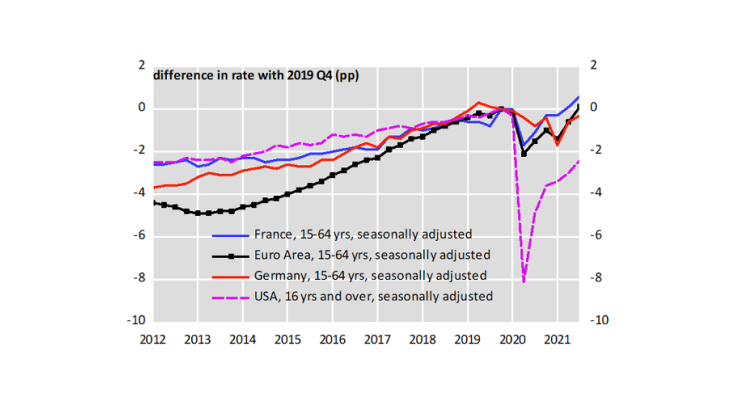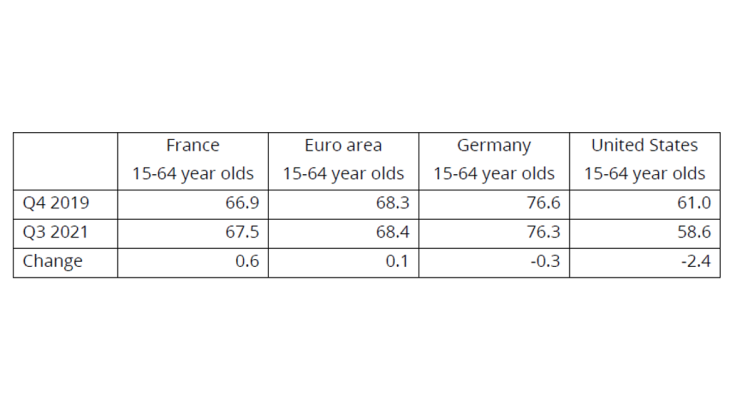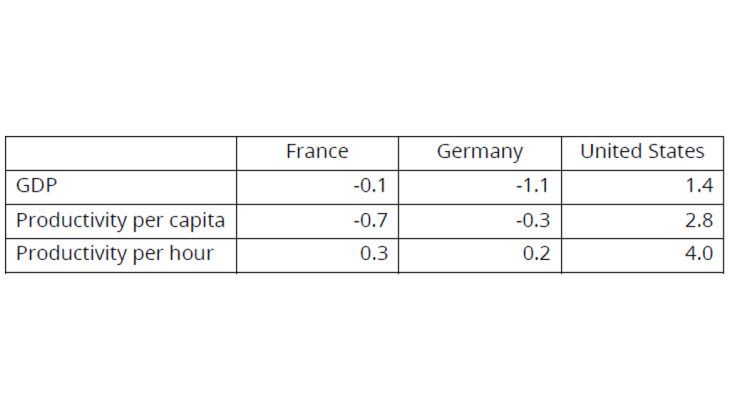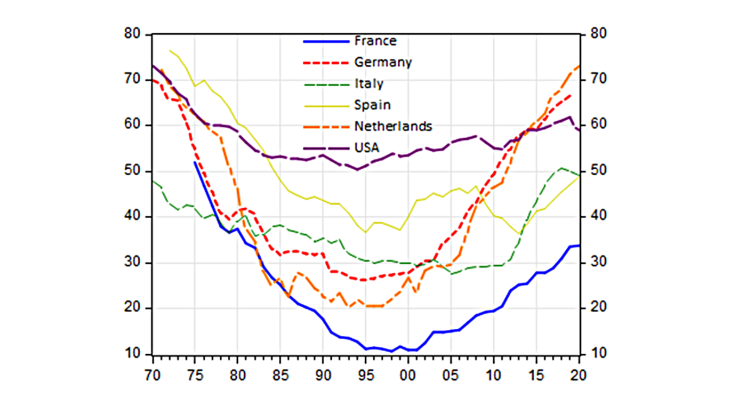- Home
- Publications et statistiques
- Publications
- The recent rise in the employment rate i...
The recent rise in the employment rate is a French particularity
Post n°258. The employment rate in France has exceeded the level reached at end-2019. This is a French particularity. It nevertheless remains low compared to other countries, in particular for young workers and men over 60. Its growth over the past twenty years had been slower than in the other major countries until recently.

The employment rate in France now exceeds the level reached at end-2019
At the height of the Covid-19 crisis, projections in early 2020 pointed to a risk of an increase in the unemployment rate in France in 2021. However, in Q3 2021, unemployment stood at the level of Q4 2019, and even fell significantly below it in Q4 2021. This stability in unemployment is linked to economic activity (see changes in GDP in Table 2), and does not result from a decline in labour participation, unlike in the United States. In France, the employment rate, which is the ratio of employment over the population aged between 15 and 64, is now above the level reached at end-2019 (Chart 1 and Table 1), and even exceeds the level of the late 1970s. This post uses figures of the Q3 2021 in order to allow for international comparisons; the last available figure for France in Q4 2021 is slightly higher (see note to Table 1). This development in France has contributed to the recovery in employment in the euro area, which displays an employment rate comparable to that of Q4 2019, despite a less favourable evolution in Germany.
The employment rate statistics are drawn from household surveys, which sometimes differ from the employment estimates obtained from business surveys, as in recent months in the United States. However, over the period from end-2019 to end-2021, this difference is moderate (employment in the United States between December 2019 and December 2021 decreased by 2.80 million according to the household survey and by 2.97 million according to the business survey).

Sources and notes: Insee, Eurostat, BLS. According to the Insee publication of 18 February 2022, the employment rate in France in Q3 2021 was revised to 67.6% and that in Q4 2021 to 67.8%.
The increase in employment in France is accompanied by a decrease in productivity per capita, given the fall in GDP, which only returned to its pre-crisis level in Q3 2021, and the growth of partial activity.

Stability of the employment rate in France at the most active ages
The particularity of the increase in the French employment rate from 2019 to 2021 stems from the employment of both the youngest and the oldest workers. The employment rate of 25 to 49 year-olds stood at 82.0% in Q3 2021, as in Q4 2019. The employment rate of 15-24 year-olds rose by 2.4 percentage points and that of 55-64 year-olds rose by 1.7 percentage points. The contrast between employment rate trends in France and the United States is more pronounced for the 55-64 age group than for the entire population. This leads us to examine more closely the issue of inactivity among older people and the increase in the number of retirees in the United States (see below the employment rate of 55-64 year-olds in the United States).
Slightly later retirement in the United States, but still after 65
During the Covid-19 pandemic, the share of retirees in the US population rose more rapidly than usual: from 18.5% at end-2019 to 19.6% in September 2021, according to the Kansas Fed.
This development can partly be explained by ageing of the population, in particular the retirement of baby boomers. The vulnerability of seniors to Covid, the favourable financial context, with historically high valuations of financial and real estate assets, have also encouraged people to retire or remain in retirement.
Thus, since 2020, there has been an excess of 1.5 to 2 million of retirees in the United States compared to the pre-Covid-19, according to the Dallas Fed and Kansas City Fed. However, this increase in the number of retirees is only observed for the age group over 65. It is therefore not really a question of earlier retirements but rather of workers who are already retired not returning to the labour market.
Indeed, the population over 65 rose by 3.3 million between 2019 and 2021. Within this group, the number of employees (and unemployed) has remained stable, while the number of inactive people, considered as retirees at this age, has increased. This development is all the more unusual as workers over-65s had been the only ones to increase their participation since the 2000s in the United States, even during the financial crisis, by re-integrating the labour market after claiming their retirement benefits. Thus, the employment rate of the over-65s posted the strongest fall during the Covid-19 crisis, dropping from 19.9% at end-2019 to 18.6% at end-2021. In contrast, the 55-64 year olds have not reduced their participation, but are more likely to be unemployed. Between end-2019 and end-2021, their employment rate recorded a smaller fall (from 64.0% to 62.8%) than that of the 25-54 year-olds (from 80.3% to 78.3%).
Slow rise in the employment rate of 60-64 year olds in France
Over the past fifty years, the employment rate of seniors has followed a more or less steep U-shaped curve depending on the country. Between 1975 and the end of the 1990s, the decrease was greater in France than in all other countries (see Chart 2). Since the start of the 2000s, the employment rate for men has been climbing in France, albeit at a slower pace than in the other countries where the rate had also fallen (Germany, the Netherlands and Italy). The comparison of changes in overall employment rates (women and men) is less striking because the employment rates by gender are close in France, whereas the female employment rate is lower in the other countries. For example, in 2020 the employment rates for women aged 60-64 stood at 33.1% in France and 41.1% in Italy, compared with 33.7% and 49.2% for men.

Source: OCDE
The rise in the employment rate of seniors is linked in particular to pension reforms, as in Germany and Italy (see the country-specific chapters in Social Security Programs and Retirement around the World: Working Longer), but it is also the result of a slow convergence. The difficulties of finding employment around the age of 60 are set out in the 2020 report "Favoriser l’emploi des travailleurs expérimentés ", and a recent review of supply and demand effects is available in “L’emploi des seniors en France”.
An employment rate that remains low in France
The employment rate of 15-64 year olds in France stood at 67.5% in Q3 2021, its highest level since the start of the series in 1975. However, it is still significantly lower than in Germany at 76.3% (Table 1). As regards the 25-55 age group, the gap is smaller (82.3% and 84.9%) and the participation rates are closer (88.3% and 87.7% respectively, with an advantage for France). The difference between employment rate and participation rate is attributable to unemployment. The gap in employment rates is therefore concentrated among the older people (see above) and young people (role of apprenticeship in Germany, with nevertheless a recent strong increase in France).
The effect of the level of education on the employment rate is differentiated between the two countries, especially for older people. In France, 60.5% of the low-skilled population (first cycle of secondary education at the most), aged between 25 and 54, is employed, compared to 65.6% in Germany. This gap in the employment rate of low-skilled workers is greater when all age groups from 20 to 64 are taken into consideration (11.2 points with 51.6% in France, compared to 62.8% in Germany), which reflects the lower employment rate of low-skilled seniors in France.
When the German employment rate is applied to the French population, the level of employment is 13% higher (+ 3 million jobs), with the difference in unemployment rates accounting for a third of the total gap. However, the difference in average annual working hours (1,511 hours in France and 1,383 hours in Germany for 2019 according to the OECD), which incorporate differences in part-time work, leads to a gap in hours worked of only 3.5%.
Updated on the 25th of July 2024